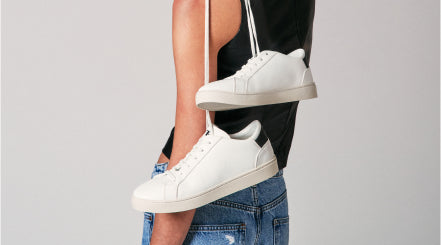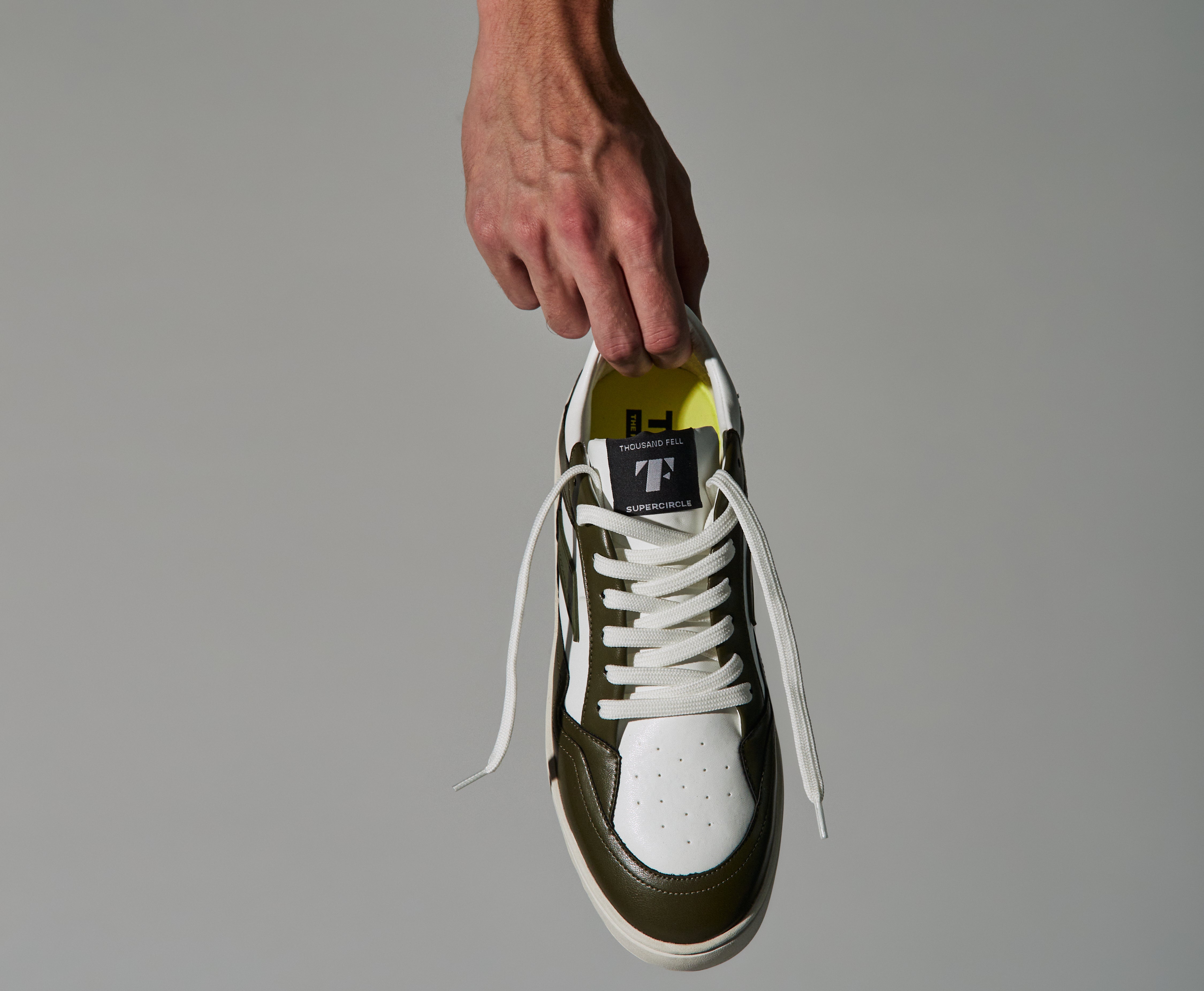NEVER SEND
ANOTHER SNEAKER
TO LANDFILL
Every pair of Thousand Fell is backed by our commitment to building a better future and is always ready to recycle. When you’re done with yours, we’ll be here to take them back and keep them out of a landfill, whether by refurbishing them and donating them to someone in need or by ensuring that their raw materials are reused.
LET US INTRODUCE YOU TO THE CIRCULAR ECONOMY
Design For the Future
Sustainable Design
Sourcing materials with lower energy, water and carbon footprints. Sourcing materials as close as possible to our factory. Incorporating previously recycled materials and naturally regenerative materials into new products. Designing out waste and pollution across the manufacturing process.
Design Products to be Recycled
Design into materials that can either easily. safely and quickly biodegrade or that can be reclaimed for recycling. Design into products that can be taken apart for recycling.
Keep Sneakers on Your Feet
Durability & Refurbishment
The first step to eliminate waste is to keep sneakers in use longer. We are focused on designing durable, long lasting sneakers that are easy to clean and refurbish.
Extended Life
If sneakers are returned to us still in good shape we will be working with Soles4Souls to give the sneakers a second life.
Keep Materials in Use
Recycle!
The key component to our closed loop system!
Our recycling facility in the US will collect used Thousand Fell sneakers. We will pull apart the sneakers and separate the different materials for recycling or composting.
Recycled materials will then be reintegrated into our own supply chain or upcycled into new supply chains here in the US. Our mission is to show you where the materials in your sneakers go — and we are launching a platform so you can track that journey.
Replenish What We Take
Restore Natural Resources
Creating sneakers takes resources. Our circular system means replenishing what we use and leaving the planet better than how we found it. One way we do this is through carbon and water offsets - taking carbon out of the air to account for the carbon we contribute and replenishing the water we use. We are also a member of 1% For The Planet where we will be funding projects and non profits that give back to the environment.
Want to learn more?
Check out our partners at the Ellen MacArthur Foundation

SOURCE
Raw materials and resources are taken from natural systems

PRODUCE
Finished products are Created and assembled

USE
End consumers use finished products throughout product lifespan

TRASH
When products reach their end-of-life or are no longer needed they are disposed of & discarded to landfill
WHY WE DON’T USE LEATHER
Leather is one of the worst material offenders when it comes to the footwear and apparel industries’ environmental footprint.
The problem starts with the heavy land use and water use required to raise cattle. Even as a byproduct of the meat industry, leather usage still supports cattle ranching which has huge environmental ramifications and is the reason for up to 80% of the current deforestation in the Amazon.
The next part of the problem is with the tanning process — how you turn skins into leather. This is an incredibly harmful process that releases toxins into the water and land surrounding tanneries and can cause serious harm to tannery workers. 80% of leather worldwide is tanned using heavy chemicals including chromium (and other suspected carcinogens).
Finally, while animal skin is natural and biodegradable, treated leather is not! It’s like a mummy! (Think, why hasn’t your mom’s leather jacket from the 90s broken down in your closet?) Many treated leathers are also coated in PU or other forms of petroleum (oil) based plastics to keep them from breaking down.
And while yes, many synthetic leather options used to be bad for the environment because they were PVC based — and many still are — there has been so much great material innovation over the past decade. Now we can use recycled plastics and food waste to create leather substitutes — that we know are better than leather! Our current bio leather has been through a lifecycle analysis to track the full environmental cost and has a 24x lower environmental cost than the average leather.
The Sustainable Apparel Coalition HIGG Index has a cradle-to-gate scoring tool that ranks all materials for their impacts across chemical use and toxicity, greenhouse gas emissions, water usage and pollution, and the depletion of natural resources and fossil fuels. This index shows that the material with the single highest impact is leather — almost 3 times that of the average synthetic leather. Because we have developed into a leather substitute made from recycled polyester and bio waste we fare even better!
*Quick Caveat* great replacements for leather are just coming to market, so don’t beat yourself up and rush to throw out your leather jacket. If you do have leather in your closet right now, it’s better to keep it in use then to throw it away!
A GROUNDED STEP FORWARD
By designing out waste and pollution, keeping products and materials in use, and regenerating natural systems we can reinvent everything.
OUR MATERIAL AND
SOURCING PRINCIPLES
We aim to establish a new standard for sourcing and design that challenges the industry. We believe that, go forward, all design should begin with end of life and product circularity in mind.
To us this means always selecting materials that are responsibility sourced — opting for lower carbon footprints, using previously recycled materials, selecting renewable alternatives whenever possible, and choosing materials located close to our factory whenever we can.
Our mission is to take out what we bring in and to leave the world better than we found it. To do this, we only source materials that can either be biodegraded (safely compost in < 1 year), be recycled to make new shoes, or upcycled into materials for new projects.
WHY WE CAN’T
RECYCLE ‘ANY SHOE’
Unfortunately the main component parts in most footwear are difficult to recycle. There can be up to 40 different materials in a single shoe - and we would have to collect many of the same shoes at scale to recycle them efficiently.
We have purposefully designed into specific materials for Thousand Fell sneakers that can easily be taken apart and that can all have a second life - partially within our own supply chain and partially upcycled into new projects here in the US.
SUSTAINABILITY AS A DTC BRAND:
OUR SHIPPING.
Shipping has an environmental impact and one of the biggest contributors is the “last mile” where packages travel from the local shipping center to your front door. In order to solve part of this problem, we are using bike messengers and local micro warehouses to deliver sneakers to our customers in NYC. The added benefit is that we will be able to offer same day delivery!
OUR PACKAGING.
We obviously couldn’t have zero waste sneakers and deliver them with extra disposable packaging! This is why we have eliminated all tissue paper and single use plastics from our packaging. Instead, we have partnered with Justa Trama a nonprofit in Brazil to wrap your sneakers in an organic cotton tote bag, please repurpose and reuse!
We are also delivering your sneakers in a shoe box that doubles as a shipping box to cut down on cardboard. All cardboard is recyclable, FSC certified, traceable, and manufactured in a facility that is carbon, water, and energy neutral. Even our tapes and our stickers meet these standards!
OUR PARTNERS
How we gut check sustainability



For more information about sustainable practices, please check out the awesome parters we are working with who are pushing us forward.





